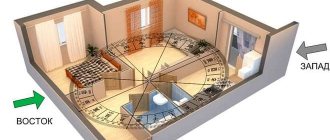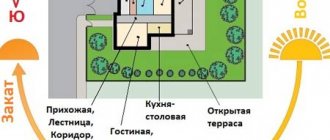You do everything to be rich: you earn money, you save money, you invest money. But there are still not enough funds?
Where is the wealth zone in your premises? What part of your home and office is responsible for the flow of money?
If the answer is “I don’t know,” then you are probably not doing the most important thing, without which it is impossible to be rich - do not strive for internal and external harmony.
This article provides recommendations for landscaping the wealth zone according to Feng Shui and Vastu Shastra.
Which of the ancient teachings should you give preference to? Whatever you like best. If you want, apply all the acquired knowledge at once! There is not much difference between them, much less contradictions.
Earth as a zone of wealth
Planet Earth is abundant, so being rich while living on it is natural.
Poverty is a sign of a departure from one’s nature, of internal inconsistency. The psychology of poverty leads to a lack of material goods.
A number of internal conflicts that prevent you from “making friends” with money need to be eliminated.
Since everything external reflects the internal, your home is also a reflection of you.
External changes and transformations in the house help to make a “monetary revolution” inside.
Moving objects in a living space is not a simple rearrangement, but a way to transform life globally and, in particular, to get rich.
Ignorance of the laws of the Universe does not exempt one from responsibility. You may not know or believe that the wealth zone in the home can be blocked, but continue to experience problems with money.
Vastu Shastra is an ancient Vedic teaching, originally from India, Feng Shui is ancient Chinese. In many ways they are similar. These are teachings about the improvement of space according to the laws of the Universe.
There is debate about which of them is more ancient, correct, and acceptable for the Slavs. However, they work equally effectively.
Read more about ancient teachings in the articles:
Vastu Shastra for home. Sacred knowledge has been declassified!
Feng Shui zones in the house: how to find and activate?
The wealth zone according to Feng Shui and Vastu Shastra can be adjusted:
- cleared,
- ennobled,
- changes.
Millions of people make changes to space with one goal - to attract material wealth. Try and change your life easily and simply - by arranging your home or office in a special way.
Vastu rules for an apartment
The central part of the apartment and the plot is under the patronage of the god Brahma, the creator of the world. In India, the central part of a house or plot is called Brahmasthan or simply Brahma. If the house or plot has the shape of a square, then the classical Paramasaika, consisting of 81 squares, can easily be superimposed on its plan, and then Brahmasthan will occupy the central 9 squares. In Vastu, it is not recommended to load the Brahmasthan with furniture, place heavy objects, and especially not to make toilets or storage rooms there. Brahmasthan should be an open space: in a private house there should be a courtyard, and in an apartment there should be a family altar.
© Ogudin Valentin
Wealth zone according to vastu
In vastu shastra the zone of wealth is:
- North - this includes the energy of wealth around the clock.
- East - here streams of abundance pour out at dawn.
The energy of wealth leaves the house through:
- West,
- Southwest,
- South,
- Southeast.
Hence 2 tasks:
- Let the energy in through the North-East wealth zone (N, NE, E).
- Do not let it flow out through the West - Southeast (W, SW, S, SE).
Two important conditions for wealth according to Vastu, which at first glance are not related to money:
- Health and happiness of the housewife. The hostess is the personification of the Goddess of prosperity named Lakshmi . It is a woman, being healthy and happy, who ensures material well-being in the family. Notice! Not by earning money or working for the benefit of someone, but by being happy and healthy, the mistress of the house contributes to the enrichment of the whole family!
- Cleanliness and tidiness. Wealth does not come to a dirty house littered with junk and things with negative energy. Such a chaotic house takes away not only money - health, harmony, mutual understanding, and other benefits.
For more information about cleaning the house according to Vastu, read “Cleansing the house before the New Year.”
| What to add to the N, NE, B wealth zones: | What to fix in wealth zones | |
| 1 | Water - a fountain or mini-pond | Wash the windows, remove all plants from the windowsill |
| 2 | Safe for all valuables with a door opening towards the North | Throw away trash, trash, anything broken, beyond repair, unnecessary |
| 3 | If there are no windows, hang mirrors on the walls | Remove heavy, massive furniture (move to the South) Bulky furniture should also not be in the NW |
| Throughout the house: | ||
| 1 | Lubricate squeaky doors | |
| 2 | Repair taps, toilets (must not leak) | |
| 3 | Take care of the strength, cleanliness and beauty of the front door | |
Interestingly, paper money is not considered valuable according to vastu shastra. Therefore, for example, it is better to put precious metals and jewelry in a safe in the North to attract wealth.
Home harmonization - how to do it right?
So, the main postulates that will help harmonize the space of our home (apartment according to Vastu):
Fresh fruit is a wonderful gift for your home. Make it a rule to always keep a bowl of fruit on the table. This is very auspicious, no entities will attach themselves to the fruit because it is a Divine product; Flowers in vases at home are very favorable: cut or live. Flowers have lunar energy, and fill you with lunar feminine energy, and from you the house will be filled with this energy
Just don’t grow creeping and climbing plants at home, as well as plants with thorns other than roses and cacti; It is very important to do general cleaning at home every 3 months, as well as energetic cleaning - with fire, sea salt, etc. It’s very good to walk around the house counterclockwise with a candle - this will clear the space, moving clockwise will fill the space
At the same time, be sure to read any mantra, prayer, or simply say: “I cleanse.” Cleaning on Maundy Thursday is especially effective. It is very important to remember that Vastu works at the level of prana, i.e. energy. The more complaints we have, the more negative energy we “attach” to this situation. Where our thought is, there is energy. Therefore, you need to clear the space so that your thoughts are also clean. Prana is light. Where can we get this light? First of all, it’s light food, bright thoughts, what surrounds us. Therefore, bring only positive thoughts into the house. And you need to start with yourself!
How does Vastu work? Let's look at this issue.
The ancient scientists who created Vastu expressed their knowledge using
concepts of primary elements, planets, gods and avatars characteristic of their culture, which were close to their contemporaries, but incomprehensible to people of our time. In modern language, what Vastu affects is called the mind. Our mind controls all the processes occurring in us: from biochemical processes to thoughts, feelings and our mood. To do this, he uses certain rules that have developed based on our experience. We may be aware of some of them, such as the habit of smoking or sitting cross-legged, but most of the mental habits we use subconsciously, without realizing them, for example, how we feel about this or that news. Our subconscious habits influence our actions every moment, ultimately determining our path in life, our destiny - or our karma, in vastu language.
When we go, for example, to the store to buy bread, we perform a certain sequence of actions that ultimately leads us to our goals. The same thing happens in all our other actions, from the manner of communication, eating habits to the way we breathe, walk and sleep. Any of our actions lead to a natural and predetermined result in our life. Even without doing anything we get a result, it could be, for example, a feeling of relaxation or weight gain. Thus, the result of the habits of our mind is our path in life. And all the objects around us are a reflection of our habitual thinking.
The house where you live, the office where you work is a warehouse for such items. All these items are a reflection of the conscious and subconscious side of your mind. By influencing them consciously through vastu, we can change our subconscious habits, thereby influencing our path in life. The ancient Indians understood this well and were able to find deep connections between surrounding objects and the subconscious. This allowed them to change the habits of our mind to more favorable ones, thus changing karma, our life path, our destiny.
The ancients believed that there was a special type of energy, which was called differently: prana, life force, bioenergy, qi, ki, etc. - and on which the physical and mental activity of a person depends. Just like an electric current “powers” your computer, prana
“nourishes” all processes in your body. It is therefore evident that the absorption of sufficient prana is an essential necessity for a healthy and joyful life of a person. When the body is charged with prana, you feel alive - you are cheerful and energetic, your mind is sharp, receptive, and yet completely relaxed.
Above the surface of the earth, prana flows easily and in abundance, so all animals and plants receive vitality without difficulty. The release of prana is a constant process, it occurs everywhere over the seas, rivers, lakes and land.
Prana is released when two substances at different energy levels interact. For example, when a river flows or a lake splashes against the shore, an interaction occurs between the masses of earth and water, as a result of which prana is released. There is no shortage of it in nature.
Buildings are an obstacle to the natural flow of prana. Modern man spends most of his life within four walls. So - the goal of Vastu science is to force the surrounding landscape and the building to interact so that prana is released inside the building. If this can be achieved, the house will turn into the same source of pranic forces as the mountains or the seashore.
What is this system based on?
It is believed that Vastu Shastra is suitable both for arranging a temple and for planning residential buildings.
To understand its principles, you need to turn to another Hindu concept: “mandala”. This is a kind of geometric Mandala model. Merriam‑Webster of the Universe, which is used to concentrate attention during meditation and to enter a trance. Such a “map” can be formed both by the space of the home as a whole, and by an image on the floor or wall. The directions in the mandala are associated with the elements.
1 / 0
The Manduka mandala is one of the most common and sacred forms of Hindu temples. Image: Mark.muesse/Wikimedia Commons
2 / 0
Mandala made of colored sand. Image: Colonel Warden/Wikimedia Commons
In total, according to the views of Hindus, there is Patra RT A Comparative Study on Vaastu Shastra and Heidegger's “Building, Dwelling and Thinking”. Asian Philosophy five spheres of energy, or five elements: water, air, fire, earth and space. All of them are related to both body parts and sidesSachdev V. Indian Architectural Theory: Contemporary Uses of Vastu Vidya. Curzon Press. 1998 light:
- northeast - water;
- southeast - fire;
- southwest - earth;
- northwest - air;
- the center is space, the Universe.
It is believed that the deity Vastu Purusha lives in every piece of land. According to legend, he was a demon until the gods pressed him to the ground and he himself became a god. Purusha lay with his head in the northeast direction and his feet in the southwest direction. According to Vastu Shastra, the diagonal of the house should run along this line.
Patra RT A Comparative Study on Vaastu Shastra and Heidegger's “Building, Dwelling and Thinking” also plays a special role in vastu. Asian Philosophy north (“roof of the world”) and east (the direction from which the sun begins to move).
Vastu Purusha lying on the ground. Image: Verena Rapp de Eston / Wikimedia Commons
In addition to the location of the house, Vastu Shastra also regulates Patra RT A Comparative Study on Vaastu Shastra and Heidegger's “Building, Dwelling and Thinking”. Asian Philosophy site planning, building proportions, architectural design and interior decoration.
The square and rectangle are considered harmonious shapes (inherent in the earth element), therefore, from the Vaastu point of view, it is advisable to Patra RT A Comparative Study on Vaastu Shastra and Heidegger's “Building, Dwelling and Thinking”. Asian Philosophy, so that the home should be exactly this shape. Also, the correct location of the house relative to the cardinal points supposedly prevents various unfriendly elements (for example, fire and water or earth and air) from colliding with each other.
The shape of fire is considered to be a triangle. Supporters of the Vastu Shastra teachings believe that a room of this type will become a breeding ground for quarrels and scandals. Also in their interpretation, the circle means air and, accordingly, mobility, restlessness, anxiety; and the semicircle - water, peace and passivity.
In addition, according to Vastu Shastra, excessive deviation towards one of the elements should not be allowed. For example, if the southwestern part of the building is proportionally larger than the others, the owners of such a home run the risk of becoming lazy. The center of the room should be free, and the house itself should be located in the southwest of the site.
The arrangement of rooms inside the building is determined by vastuPatra RT A Comparative Study on Vaastu Shastra and Heidegger's “Building, Dwelling and Thinking”. Asian Philosophy through Astrology. For example, focusing on the Moon, you should choose the location of the main entrance.
Even today, people turn to vastu to solve their everyday problems. This teaching is especially popular in its homeland: in India it is used by Sokal A. Beyond the Hoax: Science, Philosophy and Culture. Oxford University Press. 2008 even high-ranking officials. For example, the case of the head of the state of Andhra Pradesh Rama Rao is indicative. He was advised to enter his office from the east side to deal with political issues. To accomplish this, Rama Rao ordered the demolition of the slums near the relevant part of the building.
My experience in studying Vastu?
When I heard about Vastu,
As an architect, it became very interesting to me and I wanted to learn more about it. On the Internet, I easily found a variety of information about Vastu in the form of books and lectures and began to study them. But here I was faced with an unforeseen difficulty - the laws of architecture here are formulated and explained from the perspective of astrology and religion! This was completely unusual and incomprehensible for me. Even though I respect Vedic sources and am also more or less familiar with Indian culture, it was still very difficult for me to absorb information in this form. My rationalistic mind refused to understand and accept such knowledge.
This continued until I came across one book, the author of which translated the wisdom of the ancients into modern language (A. R. Hari - “Fundamentals of Vastu”). He expounded Vastu as an exact science that studies the interaction of energy fields within a building constructed by man. After reading this book, my Vastu studies became much more successful.
There was another difficulty that I encountered in studying Vastu - the large amount of conflicting information about the principles and rules of Vastu presented in books and in articles on the Internet. Then I decided that without a living teacher, a bearer of knowledge, it would not be possible to study Vastu to such an extent as to use it as an architect in my work.
Then, after some time, I had the opportunity to undergo training (I listened to 7 modules of lectures) from Indian Vastu researcher Prabhat Poddar. His approach to Vastu differs to some extent from the classical one, which is represented, for example, by Ganapati Sthapati. Prabat Poddar’s approach to Vastu turned out to be close to me and I began to use it in my work on architectural projects.
Rule of harmonious color
In Vastu design, color combinations play an important role in the harmony of space. The colors in the interior according to Vastu should be selected in harmony by a professional specialist. The best colors according to Vastu that should be used indoors to create a favorable, peaceful space are those colors that are found in the natural environment, in conditions of clear skies and bright sun. You should not use dark, “dirty” colors in a large mass, since in conditions of limited illumination of the space, this can have a “pressure” effect on the human psyche. Good colors to use on walls include creamy white, light yellow, light blue, light green and light pink. It is worth noting that the influence of color according to Vastu is mostly subtle. However, this is important when all the principles of Vastu are applied as fully as possible in the building.
Rule of natural materials
The rule of natural materials is recommended for application by the science of Vastu. The use of natural materials in construction and interior design is encouraged by Vastu as they create an ecological atmosphere in the home and offer the greatest connection with nature. Natural materials such as wood, stone, cork and others are best combined with each other and create a unique atmosphere of warmth and comfort. In any case, when designing Vastu, it is necessary to carefully approach the selection of materials and textures in order to obtain harmony of space at the level of tactile and visual perception.
Energy grid rule
The most important rule in the science of Vastu is the rule of the energy grid. A network of energy lines covers the globe. We know these lines as the magnetic grid on the surface of the Earth, latitude and longitude. The entire planet pulsates with life and radiates its energy through this grid system. The energy grid rule states that the house structure plan should also be divided into a grid of squares or rectangles. Then the house plan will be exactly above the earth's energy grid. This establishes a kind of geometric harmony with the earth's grid. Then the constructed space and the space of the planet resonate harmoniously with each other. Vastu says that a person is constantly exposed to the energy of the Earth. And to be in harmony with the energy of the planet is the goal of Vastu science. In the human heart resides an atom of divine energy through which we can vibrate with life. The earth also vibrates from within, sending out energy waves. The Vastu designer creates harmony by implementing the energy grid rule and mathematically calculating the harmonious perimeter using Ayadi.
East direction
If there is no way to store valuables in the northern corner of an apartment or office, then you should take a closer look at the eastern direction. It is not as favorable as the north, but not as dangerous as the south. If you are planning the location of the cash register in the store, you can place the cash register in the eastern corner. Having seated the cashier facing southwest, the cash register should be placed to the left of the employee. And if the cashier sits facing east, then the cash register should be located on the right. If you place a box or cabinet in the east direction, then it is better that it opens towards the north.
In Australia, a woman won the instant lottery jackpot for the second time
The opening of borders between European countries opens the shopping season (photo)
Internet users react to a rich mom's "funny" spending diary











